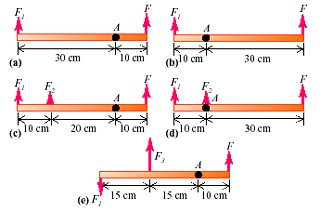Reference no: EM13997794
Assume that F1 = 48 N , F2 = 44 N , and F3 = 96 N

A.) In object A indicated in the figure, what magnitude of force F is needed to put the object into rotational equilibrium about the axis A shown?
B.) In object B indicated in the figure, what magnitude of force F is needed to put the object into rotational equilibrium about the axis A shown?
C.) In object C indicated in the figure, what magnitude of force F (if any) is needed to put the object into rotational equilibrium about the axis A shown?
D.) In object D indicated in the figure, what magnitude of force F (if any) is needed to put the object into rotational equilibrium about the axis A shown?
E.) In object E indicated in the figure, what magnitude of force F (if any) is needed to put the object into rotational equilibrium about the axis A shown?
F.) After you have found the F required to put the object into rotational equilibrium, find out which (if any) of these objects is also in translational equilibrium.